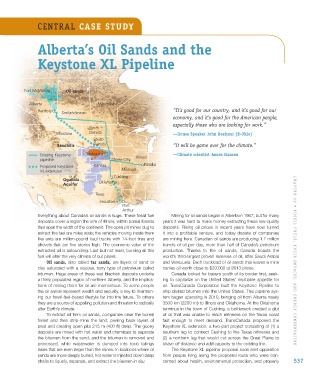Page 538 - Environment: The Science Behind the Stories
P. 538
CENTRAL CASE STUDY
Alberta’s Oil Sands and the
Keystone XL Pipeline
Fort McMurray Oil sands
Alberta Manitoba
Hardisty Saskatchewan “It’s good for our country, and it’s good for our
economy, and it’s good for the American people,
especially those who are looking for work.”
North
Montana Dakota —House Speaker John Boehner (R-Ohio)
South
Sandhills Dakota “It will be game over for the climate.”
Existing Keystone Nebraska Illinois —Climate scientist James Hansen
pipeline Steele City
Proposed Keystone Kansas Patoka
XL extension Missouri
Cushing
Ogallala
Aquifer Oklahoma
Texas
Houston
Port
Arthur
Everything about Canada’s oil sands is huge. These fossil fuel Mining for oil sands began in Alberta in 1967, but for many
deposits cover a region the size of Illinois, within boreal forests years it was hard to make money extracting these low-quality
that span the width of the continent. The open pit mines dug to deposits. Rising oil prices in recent years have now turned
extract the fuel are miles wide; the vehicles moving inside them it into a profitable venture, and today dozens of companies
like ants are million-pound haul trucks with 14-foot tires and are mining here. Canadian oil sands are producing 1.7 million
shovels that are five stories high. The economic value of the barrels of oil per day, more than half of Canada’s petroleum
extracted oil is astounding. Last but not least, burning all this production. Thanks to the oil sands, Canada boasts the
fuel will alter the very climate of our planet. world’s third-largest proven reserves of oil, after Saudi Arabia
Oil sands, also called tar sands, are layers of sand or and Venezuela. Each truckload of oil sands that leaves a mine CHAPTER 19 • FOSSIL FUELS, THEIR IMPA CT S, AND ENERGY CONSERVATI ON
clay saturated with a viscous, tarry type of petroleum called carries oil worth close to $20,000 at 2013 prices.
bitumen. Huge areas of these wet blackish deposits underlie Canada looked for buyers south of its border first, seek-
a thinly populated region of northern Alberta, and the implica- ing to capitalize on the United States’ insatiable appetite for
tions of mining them for oil are momentous. To some people oil. TransCanada Corporation built the Keystone Pipeline to
the oil sands represent wealth and security, a key to maintain- ship diluted bitumen into the United States. This pipeline sys-
ing our fossil-fuel-based lifestyle far into the future. To others tem began operating in 2010, bringing oil from Alberta nearly
they are a source of appalling pollution and threaten to radically 3500 km (2200 mi) to Illinois and Oklahoma. At the Oklahoma
alter Earth’s climate. terminus in the town of Cushing, a bottleneck created a glut
To extract oil from oil sands, companies clear the boreal of oil that was unable to reach refineries on the Texas coast
forest and then strip-mine the land, peeling back layers of fast enough to meet demand. TransCanada proposed the
peat and creating open pits 215 m (400 ft) deep. The gooey Keystone XL extension, a two-part project consisting of (1) a
deposits are mixed with hot water and chemicals to separate southern leg to connect Cushing to the Texas refineries and
the bitumen from the sand, and the bitumen is removed and (2) a northern leg that would cut across the Great Plains to
processed, while wastewater is dumped into toxic tailings shave off distance and add capacity to the existing line.
lakes that are even larger than the mines. In locations where oil The Keystone XL pipeline proposal soon met opposition
sands are more deeply buried, hot water is injected down deep from people living along the proposed route who were con-
shafts to liquefy, separate, and extract the bitumen in situ. cerned about health, environmental protection, and property 537
M19_WITH7428_05_SE_C19.indd 537 12/12/14 5:22 PM

